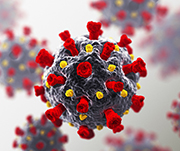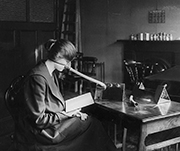Campus Quarantines
BY DUANE BEESON

GETTY IMAGES
A woman wears a flu mask during the 1918 Spanish influenza pandemic.
When Northwestern sent students home in March because of the COVID-19 pandemic, it wasn’t the first time the school year had been interrupted due to a public health emergency.
1918–19
Northwestern Classical Academy Principal Thomas Welmers reported to the board in the spring of 1919 that the school had been closed for 15 days because of what was known as the Spanish flu. Welmers reported no deaths but much sickness among students.
There was no Beacon at the time, and archival information is limited, but it’s clear the Academy wasn’t spared from the pandemic that eventually claimed 675,000 lives in the U.S. and 50 million worldwide.
The U.S. Public Health Service (PHS) described the influenza as a “very contagious kind of ‘cold,’ accompanied by fever, pains in the head, eyes, ears, back or other parts of the body, and a feeling of severe sickness.” Symptoms often disappeared after a few days, but some patients developed pneumonia or meningitis that could become fatal.
Area newspapers reminded residents to “Cover up each cough and sneeze. If you don’t, you’ll spread disease.” They also shared this advice from the PHS: “It is very important that every person who becomes sick with influenza should go home at once and go to bed. This will help keep away dangerous complications and keep the patient from scattering the disease. No one but the nurse should be allowed in the room.”
The disease came in waves, with military camps often taking the worst hits. In one 12-hour period at Camp Dodge in Des Moines, 1,000 new cases were reported. Soldiers weren’t allowed to leave and visitors were banned, but civilian laborers performing construction at the camp kept working—and used crowded streetcars to get there. Des Moines schools, churches and places of amusement were closed for 18 days in October, and residents were required to wear face masks.
In Omaha, a similar public health order was released, with the public urged to refrain from kissing and using common drinking cups. Eventually nearly 1,200 people died from the disease in Omaha and 6,000 in the state of Iowa.
1930
Northwestern was closed for eight days in March 1930 due to scarlet fever, a bacterial infection that can occur after strep throat and is often accompanied by a high fever, headaches and a rash. Seven students became ill, according to the March 21, 1930, Beacon, which reported that they had to be “locked up” for 28 days.
A few weeks later, the April 14 Beacon gave this optimistic exhortation: “Only seven weeks of school left and then examinations. We surely are glad we didn’t need to close school again. We licked the scarlet fever—let’s lick our studies so they’ll be quarantined for three months.”
 March was the start of uncertainty and upset as the novel coronavirus shut down campus and forced students and professors into Zoom classrooms.
March was the start of uncertainty and upset as the novel coronavirus shut down campus and forced students and professors into Zoom classrooms. Everyone is an expert in something. We found alumni, faculty, staff—and a student—who were willing to share their how-to advice. Check out their stories to benefit from their hobbies, occupations and interests.
Everyone is an expert in something. We found alumni, faculty, staff—and a student—who were willing to share their how-to advice. Check out their stories to benefit from their hobbies, occupations and interests. Soccer alumnus Matt Dowie faces multiple sclerosis with an athlete’s grit and endurance—and faith in Jesus’ promise that he has overcome the world.
Soccer alumnus Matt Dowie faces multiple sclerosis with an athlete’s grit and endurance—and faith in Jesus’ promise that he has overcome the world. In 1918–19 and again in 1930, Northwestern’s campus was closed for several days due to public health emergencies.
In 1918–19 and again in 1930, Northwestern’s campus was closed for several days due to public health emergencies.
Classic Comments
All comments are moderated and need approval from the moderator before they are posted. Comments that include profanity, or personal attacks, or antisocial behavior such as "spamming" or other inappropriate comments or material will be removed from the site. We will take steps to block users who violate any of our terms of use. You are fully responsible for the content that you post. Comments posted do not reflect the views or values of Northwestern College.